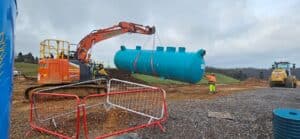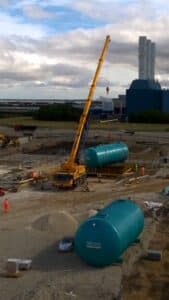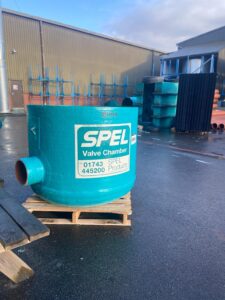At A Glance:
- Location : Silvertown Tunnel, London
- Client: Transport for London (TfL)
- Consultant: Arup
- Contractor: Riverlinx CJV
Products Supplied:
- Models supplied: 15no. in total consisting of: 103C1/SC, 204C1/SC, 3no. 206C1/SC, 210C1/SC, 215C1/SC, 5no. 320C1/SC, 460C1/SC and 2no. 4100C1/SC
- BS EN 858 third party certification by HR Wallingford
- From 3 litres per second to 800 litres per second flow rate
(Nominal Size) within a single unit - From 30 l/s up to 8,000 litres per second peak flow rates
- Large range of tank shell specifications to cater for varying burial depths and ground water levels. 25 Year Tank Shell Warranty supplied with all.
- One of these Stormceptors was supplied as an aboveground unit, which is something that SPEL offer, but is rarely used.
- BS EN 858 compliant oil separator – as Third Party tested by HR Wallingford.
- Large range of flow rates from small 4 l/s flow rates, up to large 1000 l/s flow rates.
- Includes an Automatic Closure Device (ACD) that will automatically close off the system in the event of a large oil spill.
- Often used on motorway maintenance depots or compounds where fuel refuelling or other high risk activities may take place, thanks to the oil spill capacity and ACD within a SPEL Puraceptor
- Full retention separator tested to Class 2 standard in line with BS EN 858, allowing for discharge to a foul network only. Class 2 certification requires the separator to discharge a maximum of 100mg/l, whereas Class 1 requires a maximum of 5 mg/l
- Often used for washdown water which cannot be discharged to a surface water system because of the detergents/chemicals used in vehicle washdown processes.


This new 1.4km twin-bore road tunnel under the Thames will be the first in London in over 30 years, with estimated costs of around £1.2 billion for its construction. This modern tunnel will have a user charge and improved cross-river public transport will improve transport links for all. The tunnel will also include good walking and cycling areas and the areas near the tunnel entrances will be part of a major regeneration. When it opens in 2025 the Silvertown Tunnel will reduce delays at the Blackwall Tunnel, with journey times predicted to be up to 20 minutes faster whilst reducing the environmental impact of traffic congestion.
The SPEL Stormceptor Bypass oil separators were strategically positioned down the full length of the tunnel and incoming and outgoing carriageway, treating the highway run-off to a BS EN 858 Class 1 standard before discharging. All of the models used included a silt capacity for capturing silt pollution within the road runoff. If silt and metals pollution is a concern, the SPEL ESR Bypass has been WRc tested for silt and metal pollution with high removal rates achieved in testing. SPEL could have provided one large SPEL Stormceptor to take the flow from the full carriageway but due to drainage levels and the discharge points available, multiple smaller SPEL Stormceptors were better suited to this project.
The SPEL Puraceptor was installed within the highways maintenance area due to the potential high risk activities such as refuelling and other oil spills that may occur. These oil spillage risks require a SPEL Puraceptor due to the Automatic Closure Device that will close off in the event of a catastrophic oil spill. The SPEL Puraceptor treats 100% of the flow, therefore no spillage can bypass in a storm conditions.
The SPEL Class 2 full retention separator was installed within the site compound to be used as a washdown separator with Class 2 BS EN 858 certification. BS EN 858 suggests that Class 2 full retention separators should be used for washdown areas as they have certified hydrocarbon removal rates and also have an Automatic Closure Device (ACD) that will close off the system in a catastrophic oil spillage, or if the oil accumulates beyond a certain level, ensuring no oil spillage occurs. Class 2 separators are only certified for discharge to the foul sewer. All washdown water must discharge to the foul sewer due to the detergents and cleaning chemicals used.





